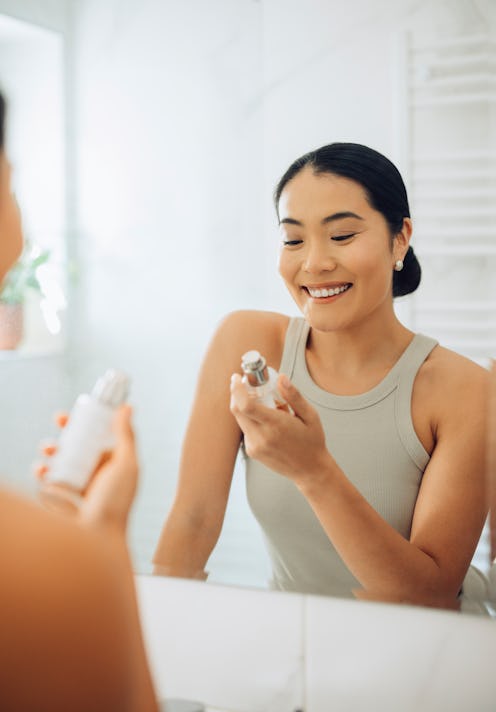Beauty
A Cosmetic Chemist Explains TikTok's Viral Vitamin C Test
Is it worth it?

TikTok users are known to take beauty matters into their own hands, posting DIY experiments, hacks, and challenges involving everything from makeup sponges to chlorophyll in order to test the efficacy of certain products. One such experiment that has been floating around the platform recently involves vitamin C serums and apples. Typically, users will drop product onto apple slices and observe changes in the color and size over the course of a few hours or several days. The less brown and shriveled the slice is, the more effective the serum is assumed to be. SkinCeuticals C E Ferulic, HelloBody 10% Vitamin C Booster, and Tropic Skincare Glow Berry Brightening Serum are just a few of the vitamin C serums that have been used.
Leah Woodcock, a product manager based in London, was inspired to try the experiment on her own, putting four popular vitamin C serums she had on hand — specifically, Ole Henriksen Banana Bright 15% Vitamin C Serum, Bliss Bright Idea Vitamin C + Tri-Peptide Serum, Summer Fridays CC Me Vitamin C Serum, and ViolaSkin Anti Ageing Vitamin C Serum — to the test. Woodcock dropped a pea-sized amount of each serum onto thin slices of a Granny Smith apple, watching them over the course of five days. (She also included an apple slice with nothing on it in the lineup to act as a “control” in the experiment.) “I was inspired to do it because I have loads of vitamin C [serums] and I don’t trust marketing,” she tells Bustle. After the five days were up, Woodcock says Ole Henriksen’s vitamin C serum looked the brightest and healthiest, while the others “shriveled dramatically in comparison.”
So, what gives? Does it depend on the percentage of vitamin C included in the serum? And — why apples? According to Ron Robinson, cosmetic chemist and founder of BeautyStat, apples are particularly useful instruments to measure the potency of vitamin C because they’re antioxidant-rich. “A freshly cut apple turns brown due to oxidation,” he tells Bustle over email. “When you apply a vitamin C serum to an apple, it works as an antioxidant to prevent oxidation and thus it does not turn brown.”
There are three key skin care benefits to vitamin C, Robinson explains. “It can work as a powerful antioxidant to protect the skin from free radical damage, help stimulate collagen production to firm the skin and decrease the look of fine lines and wrinkles, and help prevent the over-production of melanin to even skin tone and reduce the look of hyperpigmentation.” He adds that the ideal amount of vitamin C that a serum should contain is around 10 to 20 percent.
The winner of Woodcock’s experiment — Ole Henriksen Banana Bright 15% Vitamin C Serum — contains 15 percent vitamin C, plus five percent poly hydroxy-acids (aka chemical exfoliants known as PHAs), hydrating hyaluronic acid, and 3-O ethyl ascorbic acid (a gentler and more stable form of vitamin C). “Vitamin C [is a] great skin-brightener. However, it can be extremely difficult to find one that will remain stable, efficacious, and active in the formulation,” Ole Henriksen’s product development team tells Bustle. “We included 3-O ethyl ascorbic acid in our formula as we believe it is a next-generation enhanced form of vitamin C and is considered to be more stable in the lifecycle of a formula and product compared to ascorbic acid.” Using vitamin C and PHAs together, the team adds, helps Banana Bright Vitamin C Serum deliver all the benefits of vitamin C, like hydration, exfoliation, and fine line and wrinkle reduction.
When seeking out a vitamin C serum, it’s a good idea to see whether or not the product contains added vitamin C derivatives (like Ole Henriksen’s does) to ensure maximum potency and stability. “Because vitamin C itself is an antioxidant, a vitamin C serum can oxidize when exposed to air or light,” Robinson says. This can cause it to turn brown (just like an apple would) and lose its efficacy. To stabilize it, some manufacturers combine pure vitamin C with derivatives, like magnesium ascorbyl phosphate, sodium ascorbyl phosphate, ascorbyl palmitate, and ascorbyl glucoside, he says.
If these ingredients conjure up painful memories of chemistry class, just look for a vitamin C serum with added antioxidants. Robinson points to BeautyStat’s Universal C Skin Refiner, which contains 20 percent of pure vitamin C plus Epigallocatechin gallate (or EGCG), an ingredient in green tea that’s proven to hydrate skin and prevent wrinkles, as another solid and long-lasting vitamin C serum.
Have a little time on your hands? Try out the experiment for yourself using whatever vitamin C serums you have in your arsenal. In addition to being fun, the experiment is also effective. “The apple experiment is a great visual that shows the antioxidant benefits that vitamin C provides,” says Robinson.
Studies:
Eunji K, et al. (2018). Skin Protective Effect of Epigallocatechin Gallate. Int J Mol Sci. https://pubmed.ncbi.nlm.nih.gov/29316635/
Experts:
Ron Robinson, cosmetic chemist and founder of BeautyStat